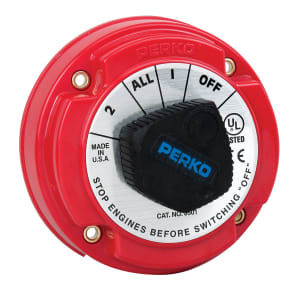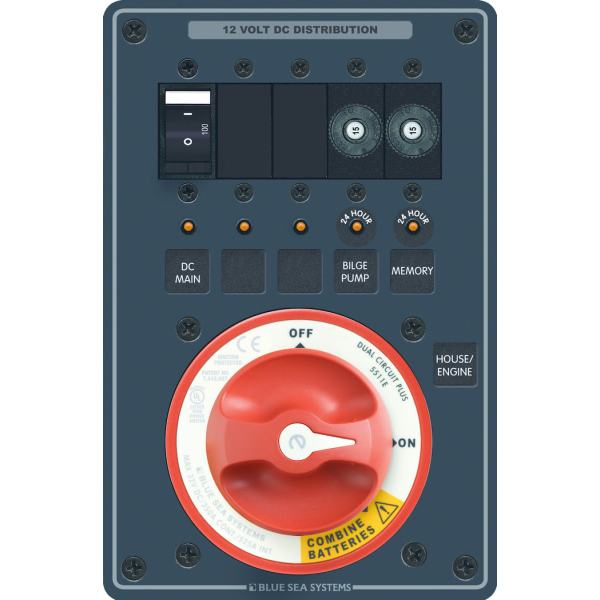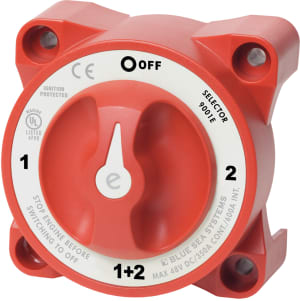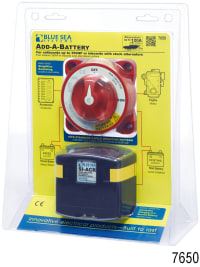Marine Battery Switch Basics
What is a marine battery switch and how does it work?
A marine battery switch is a device that allows you to control the flow of electrical power between multiple batteries on a boat. It connects or disconnects the batteries in different configurations, such as parallel or series, to provide power to different systems or charge the batteries.

Understanding the Basics: Battery Banks
Any boat equipped with more than one battery typically organizes them into distinct "banks." The primary purpose of these banks is twofold: one is dedicated to starting the engine (commonly known as the "start" battery bank), and the other, often referred to as the "house" bank, powers onboard appliances such as refrigeration units, lights, and electronics.
Why the Need for Separation?

Enter the Battery Switch: A Captain's Control Center
This brings us to the indispensable device — the battery switch. Essentially, a battery switch provides complete control over which bank is in use or being charged. It's the captain's control center, ensuring the seamless operation of the boat's electrical systems. Battery switches typically come with four positions:
- OFF: In this position, the alternator doesn't charge any of the battery banks during engine operation. However, when connected to shore power, the switch is bypassed, allowing all banks to charge regardless of the switch setting.
- Position 1: This position is usually assigned to the start battery. It provides maximum power to start the engine or charges the start battery using the alternator while the engine runs.
- Position 2: Position 2 is typically designated for the house bank. It powers onboard appliances when you're anchored, supplying energy to items like refrigeration units and lights. Additionally, it charges the house bank through the alternator while the engine is running.
- ALL (or 1+2): Selecting this position enables the use or charging of all batteries simultaneously. While it might seem like the perfect setting, there's a caveat. Running all batteries in this mode risks depleting them entirely, potentially leaving you unable to start the engine when you need to leave the dock or the mooring the following day.
A Word of Caution: Beware of the "ALL" Setting

Optimizing Battery Switch Usage: A Recommended Strategy

Automatic Battery Management Solutions: A Hassle-Free Option

Understanding AFD (Alternator Field Disconnect) for Enhanced Safety
When your boat's engine is in operation, the alternator charges your batteries. In boats without a battery isolator, it's common for the alternator's output to connect to the load side of the battery selector switch. This setup allows you to select the bank you wish to charge. However, a potential problem arises if the battery switch is accidentally turned to the "OFF" position while the engine is running. Passing through the OFF position, even momentarily, interrupts the alternator's output, leading to a voltage spike. This spike, often reaching several hundred volts, can damage the alternator's diodes and voltage regulator, rendering them useless.

Battery Isolator: A Different Solution
Boats equipped with a battery isolator maintain a constant connection between the alternator and the batteries. In such cases, an AFD switch isn't necessary, as the alternator remains connected, regardless of the battery switch position.
Mastering the intricacies of battery switches is essential for every boat owner. It's not merely about understanding their functions but also about adopting the best practices that enhance both efficiency and safety. Whether you choose manual battery switches or opt for automatic systems, the goal remains the same: to ensure your vessel's electrical systems operate seamlessly, providing you with the convenience and preservation of battery life needed for a pleasant boating experience. If you are looking for a way to ensure that your batteries stay charged for a full day out on the water, check out our extensive inventory of marine battery switches, including single engine and single battery options, from all the top brands. ABYC requires a battery switch in every boat with a battery over 800 CCA for safety purposes.
The Importance of Regular Maintenance
Understanding how to use your battery switch effectively is just the first step. Regular maintenance is crucial to prolonging the lifespan of your batteries and ensuring they perform optimally. Here are some key maintenance tips:
- Inspect your batteries regularly: Check for signs of corrosion, leaks, or damage. Clean the battery terminals and connections to prevent electrical resistance.
- Keep your batteries charged: Discharged batteries can suffer from sulfation, reducing their capacity. Charge your batteries regularly, especially if your boat is not in use for extended periods.
- Monitor electrolyte levels: For flooded lead-acid batteries, ensure the electrolyte levels are within the recommended range. Add distilled water if necessary.
- Secure your batteries: In a marine environment where boats are subject to vibrations and movements, secure your batteries properly to prevent damage.
- Consider a battery monitor: A battery monitor provides real-time information about your battery's state of charge, allowing you to manage your power consumption effectively.
Choosing the Right Battery Switch
Selecting the appropriate battery switch for your boat is paramount. Consider the following factors:
- Voltage and Current Rating: Ensure the switch can handle your electrical system's voltage and current requirements. This information is usually labeled on the switch.
- Durability: Look for switches made from corrosion-resistant materials, especially if your boat operates in saltwater environments.
- Type of Battery: Different types of batteries (lead-acid, AGM, lithium) have varying charging requirements. Ensure the switch is compatible with your battery type.
- Installation: Consider the ease of installation. Some switches might require professional installation, while others are designed for user-friendly setup.
- Automatic vs. Manual: Decide whether you prefer the convenience of automatic systems like the Automatic Charging Relay (ACR) or if you're comfortable with manual switches.
- Manufacturer Reputation: Opt for switches from reputable manufacturers known for their reliability and durability.
We hope this Navigator has helped you understand what battery switches are used for and whether you need the AFD feature when adding one to your boat. If you have further questions or need clarification, please don’t hesitate to contact our experts at (800) 426-6930.
On boats equipped with a battery isolator, the alternator is always connected to the batteries, so if you have a battery isolator you do not need this feature in your battery switch.
We hope this Navigator has helped you understand what battery switches are used for and whether you need the AFD feature when adding one to your boat. If you have further questions or need clarification, please don’t hesitate to contact our experts at (800) 426-6930.